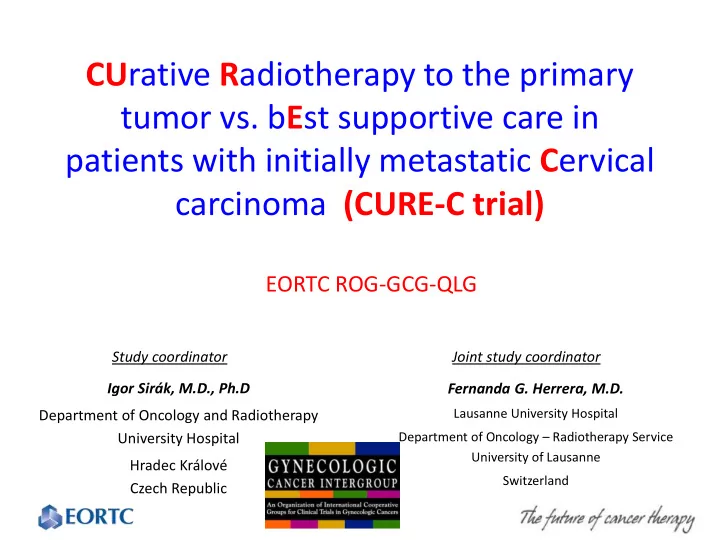

CU rative R adiotherapy to the primary tumor vs. b E st supportive care in patients with initially metastatic C ervical carcinoma (CURE-C trial) EORTC ROG-GCG-QLG Study coordinator Joint study coordinator Igor Sirák, M.D., Ph.D Fernanda G. Herrera, M.D. Lausanne University Hospital Department of Oncology and Radiotherapy Department of Oncology – Radiotherapy Service University Hospital University of Lausanne Hradec Králové Switzerland Czech Republic
Introduction • Metastatic stage IVB disease present in 15-20% of CC patients at diagnosis • Platinum-based chemotherapy +/- individualized radiotherapy standard of care in metastatic disease (NCCN 2.2015) No radomized trial of radiotherapy in the setting of primary metastatic CC
GOG 110 cDDP+paclitaxel + bevacizumab GOG 110 cDDP+paclitaxel (vs. other combo) GOG 110 cDDP+paclitaxel GOG 110 cDDP+IFO GOG 110 cDDP+topotecan GOG 149 cDDP+IFO+Bleo GOG 64 cDDP 50 mg/m2
Introduction Pelvic/para-aortic progression is still a very common cause of death even in initially metastatic cervical carcinoma: causing hydronephrosis and renal failure with uremia, bleeding, thromboembolism, pelvic organ fistulas or tumor necrosis with consequent lethal sepsis Furthermore, primary cancer cells continue to disseminate to generate more metastatic foci (Lyng 2006, Su 2012, Donat 2014) Distant metastases remain asymptomatic for a long time and represent a direct cause of death less frequently (e.g. liver failure, carcinomatous lung lymphangoitis, brain edema, etc.) Radiotherapy of the primary cervical carcinoma and pelvic/para-aortic lymph nodes to a “curative” dose as used in locally advanced disease may have a huge potential to improve outcomes in initially metastatic CC
Purpose To prove the superiority of primary tumor radiotherapy to “curative” doses over palliative treatment (best supportive care) in the setting of initially metastatic stage IVB cervical carcinoma in patients with response after standard platinum-based systemic chemotherapy
Inclusion criteria • Histologically confirmed cancer of the uterine cervix • Stage IVB metastatic disease • No clinical evidence of brain metastases • Presence of untreated primary cervical carcinoma • No need for urgent upfront radiotherapy for life threating symptoms • No previous RT treatment in the pelvis or para-aortic area • No prior history of Crohn’s disease, ulcerative colitis; or other chronic bowel disease • Performance status 0-2 • Life expectancy ≥ 6 months • Adequate hematological formulae
Phase II randomized trial R A N D O M S T A N D A R D A R M I E X P E R I M E N T A L A R M Z A PLATINUM-BASED T RT CHT 4x (+/- BEV) I O N BSC: including palliative RT up to 40Gy BED2 in case of symptomatic progression, 2 nd line CHT, etc.
Endpoints Primary : Time to progression Secondary : Quality of life (A Translational part of the research) Overall Survival Treatment toxicity Evaluation of treatment feasibility in a multi-institutional setting Response to initial chemotherapy by RECIST criteria: CR, PR vs. SD Stratification factors Performance status Bevacizumab yes/no
Statistics Due to the variability of the BSC, a comparative phase II design is proposed As proposed by Korn et al (JCO 2001), a phase II comparative screening design can be implemented as a superiority phase III trial design with an increased type I error and optimistic treatment effect For this trial, using a one sided log-rank test at a level of significance of 10% (alpha), to test for a HR=0.63 (increase from 50% to 65% event-free survival at 12 months) at 80% power would need about: • 80 events ~100 patients in 1:1 randomization. The event-free curves between the two arms will be compared with a non- parametric test stratified for the stratification factors With the above assumptions, a hazard ratio of minimum would need to be observed 0.75 to reach significance
Recommend
More recommend